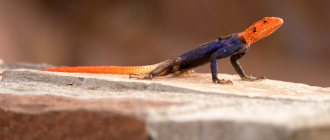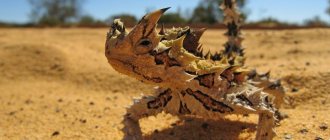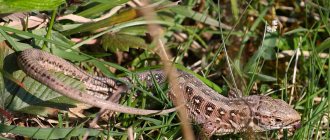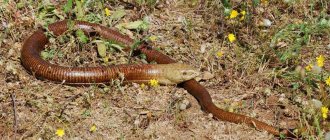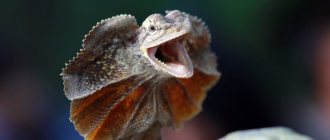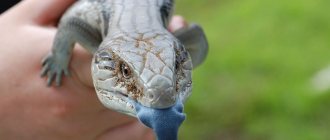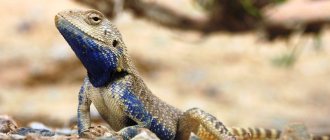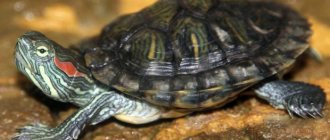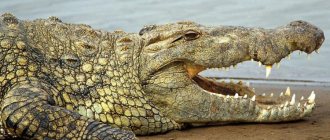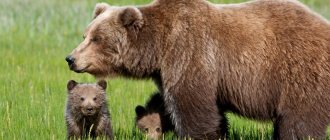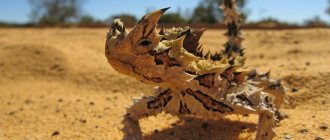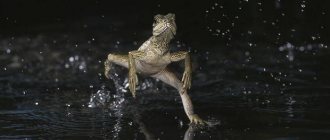In the tropical rainforests of the southern hemisphere of our planet, there are thousands of species of diverse fauna. The most exotic species of mammals, amphibians and birds live here. Their most striking representative is the dragon lizard. This is a small reptile with wings that, upon closer inspection, closely resembles the main character of Chinese folklore.
The flying dragon has a relatively small body
External signs of a flying lizard.
The flying lizard has large “wings” - leathery outgrowths on the sides of the body. These formations are supported by elongated ribs. They also have a flap, called a dewlap, which is located under the head. The flying lizard's body is very flat and elongated. The male is about 19.5 cm long and the female is 21.2 cm long. The tail is about 11.4 cm long in the male and 13.2 cm in the female.
Common flying dragon, flying lizard - representative of agamidae
Dracos is distinguished from others by rectangular brown spots located on the upper part of the wing membranes and black spots below. Males have a bright yellow dewlap. The wings are bluish on the ventral side and brown on the dorsal side. The female has slightly smaller dewlaps and a bluish-gray tint. In addition, the wings on the ventral side are yellow.
Reproduction of a flying lizard.
The breeding season of flying lizards is believed to be between December and January. Males and sometimes females exhibit mating behavior. They spread their wings and shake their whole bodies when they collide with each other. The male also fully spreads his wings and in this state circles the female three times, inviting her to mate. The female builds a nest for the eggs, forming a small hole with her head. There are five eggs in the clutch; she covers them with earth, compacting the soil with the clap of her head.
The female actively guards the eggs for almost a day. Then she leaves the clutch. Development lasts about 32 days. Small flying lizards can fly right away.
Habitats
The small, harmless reptile is found near the equator and in southeast Asia.
Reptiles live in a number of countries
Its natural habitat includes:
- Myanmar;
- India;
- Southern China;
- Kalimantan Island (Borneo);
- Malay Islands;
- Indonesia and the Philippines;
- Bangladesh;
- Eastern part of Vietnam and Thailand.
The flying lizard prefers places far from cities and villages. That is why it is difficult for a person to meet this exotic animal in the wild.
Flying lizard behavior.
Flying lizards hunt during the day. They are active in the morning and afternoon. At night, flying lizards rest. This life cycle avoids the daytime period with the highest light intensity. Flying lizards do not fly in the full sense of the word.
They climb onto tree branches and jump. When jumping, lizards spread their wings and glide towards the ground, covering a distance of about 8 meters.
Before flying, lizards turn their heads down towards the ground, gliding through the air helps lizards move. Lizards do not fly during rainy and windy periods.
To avoid danger, lizards spread their wings and glide downwards. Adults are extremely mobile and very difficult to catch. When the male encounters other lizard species, he displays several behavioral responses. They partially open their wings, vibrate their bodies, and 4) fully open their wings. Thus, males try to frighten the enemy by demonstrating enlarged body shapes. And the female is attracted by her beautiful, spread wings. Males are territorial individuals and actively protect their area from invasion, which usually has two or three trees and is home to one to three females. Female lizards are obvious candidates for mating. Males defend their territory from other males who do not have their own territory and compete for females.
Variety of species
Scientists know about thirty species of winged lizards. Among them the main ones are:
- ordinary;
- reticulate;
- spotted;
- bloodbeard;
- five-way;
- Sumatran;
- horned;
- Blanford.
All flying agama lizards are united by the presence of wings. They differ from each other in size, habitat and different colors. The color palette is determined by the color of the surrounding nature.
Sumatran lizard
Unlike other representatives of its kind, it prefers abandoned parks and degraded forest areas near human habitation. Not found in wild jungles or remote areas.
Maximum body length is 9 cm.
They are the smallest of the flying dragon family. Body length is only nine centimeters
, the color is gray or brown almost indistinguishable from the bark of the trees on which they live.
Horned dragon
A unique species that lives on the island of Kalimantan. Includes two populations. One of them lives in mangroves, the other prefers lowland rain forests. A remarkable feature of horned lizards is their ability to camouflage themselves as falling leaves. The mangrove dragon has red membranes, while its relative has green membranes with a brown tint.
Imitation of falling leaves allows animals to float freely in space without fear of attack by birds of prey. According to scientists, reptiles do not use their camouflage for communication. Individuals that have migrated to other forest zones acquire an adaptive membrane color. In any place where they live, they imitate leaf fall.
The ability for divergent evolution distinguishes the miniature lizard from many representatives of the fauna of our planet. Nature has endowed them with the ability to fly.
and camouflage as the only way to survive in the harsh conditions of the wild jungle.
In this video you will learn more about the little dragon:
The dragon lizard, or as it is also called the flying lizard, is considered one of the most prominent representatives of the subfamily of Afro-Arabian agamas. These unique creatures are quite miniature in size and are able to fly thanks to their unique wings.
The flying lizard is a fairly inconspicuous animal, which, due to its small size and color, is able to blend into a tree. The length of this lizard does not exceed forty centimeters, most of which is the tail, which, among other things, also performs the function of turning during flight. The body of all these creatures is very narrow and is about five centimeters in thickness.
Distinctive features
A distinctive feature of a dragon in the form of a lizard is that it has corrugated folds on both sides of the body, which straighten during flight and form wings. The difference between males and females is that the former have a special fold on the throat, which serves as another wing, only to stabilize the body position during flight, as well as to attract females and scare away opponents.
flying Dragon
Another distinctive element is the brown-gray color of the individuals with a metallic sheen, which allows the lizards to be completely invisible on the tree. These creatures also have lateral membranes on both sides, which alternate one after another and are distinguished by a fairly bright color. The upper side of the dragon mainly shimmers in a variety of colors, which includes red and yellow shades, which in turn are complemented by various inclusions, stripes and spots. As for the lower side, there are mainly yellow and blue colors there. Among other things, the animal’s abdomen, tail and paws are also distinguished by bright shades.
Note! The dragon lizard is a fairly common reptile species. That is why the animal is not on the list of endangered species.
Habitats
Having first heard about such a unique creature as the flying dragon lizard, many wonder where this animal lives. Most often this animal can be found in the following places:
- in India;
- in Malaysia;
- on the islands of the Malay archipelago;
- on the island of Borneo;
- in much of Southeast Asia.
Lizards practically do not descend to the ground
In order to get food, the lizard sits on or near a tree and waits for insects to appear. As soon as the insect appears in close proximity to the reptile, it deftly eats it, without even displacing the animal’s body.
The flying lizard (Draco volans) belongs to the family Agamidae lizards, order Squamate. The species name Draco volans translates as "common flying dragon".
Why can lizards fly?
Flying lizards have adapted to living in trees. The color of the skin of flying dragons is monochromatic green, gray-green, gray-brown, merging with the color of the bark and leaves.
Skeleton of Draco volans
This allows them to remain invisible if the lizards are sitting on branches. And the bright “wings” make it possible to soar freely in the air, crossing space at a distance of up to sixty meters. The spread “wings” are colored in green, yellow, purple shades, decorated with spots, specks and stripes. The lizard does not fly like a bird, but rather plans, like a glider or parachute. For flight, these lizards have six enlarged lateral ribs, the so-called false ribs, which, when expanded, extend a leathery “wing”. In addition, males have a noticeable fold of bright orange skin in the throat area. In any case, they try to demonstrate this distinctive feature to the enemy, sticking him forward.
Flying dragons practically do not drink; they compensate for the lack of fluid from food. They easily detect the approach of prey by ear. For camouflage, flying lizards fold their wings when sitting in trees.
The color of the body covers blends with the background of the environment. Flying reptiles glide very quickly, not only downwards, but also upwards and in the horizontal plane. At the same time, they change the direction of movement, dodging obstacles that arise along the way.
Features of nutrition and reproduction
The winged lizard is known to eat insects. Their menu includes:
- wood ants;
- beetles and butterflies;
- termites;
- insect larvae.
Leading a sedentary lifestyle, the flying dragon lizard can wait for hours for prey to appear. As soon as this happens, the reptile catches and swallows the victim, without changing its body position.
The dragon feeds on various butterflies.
While hunting for flying insects, it glides between branches and catches prey. Grabbing it with his teeth, he returns to the tree and eats it. The necessary liquid is obtained from food, so the reptile does not need water. Among natural enemies, the main ones are birds of prey and snakes, from which the lizard hides, merging with the environment.
The flying dragon is an oviparous lizard. During the mating period, the male inflates his bright folds, thereby demonstrating to the female his beauty and readiness for procreation. The female lays two to four eggs. To protect them from predators, she buries them in small holes dug in the soil. Masks the nest with leaves and dirt. She is helped in this by her pointed nose, specially adapted for such manipulations.
The reptile guards the clutch for one day, after which it returns upstairs. After a few months, the cubs hatch, ready for independent life and with the ability to fly.
The hidden lifestyle does not allow scientists to thoroughly study the lizard. It is not yet known how many babies are born to one individual, as well as how long they live. But the number of these animals is not critical, and they do not fall under the status of protected animals.
Where does the Komodo dragon live?
This species of monitor lizard originated and developed in Australia, this is their historical homeland. And about 900 thousand years ago, the Komodo dragon began to populate the nearby islands. Now the Komodo dragon lives in the country of Indonesia on the islands that are part of the Lesser Sunda Islands:
- Flores, numbering about 2,000 individuals, live exclusively near the coast due to human activities.
- Komodo, estimated population 1,700 individuals.
- Rinca, with an estimated population of 1,300 individuals.
- Gili Motank, less than 100 individuals.
As a habitat, the Komodo dragon chooses mainly dry, well-warmed areas by the sun. Therefore, the Komodo dragon lives in arid plains, savannas, and dry tropical forests. Quite often this predator can be found on the coasts in search of food.
Komodo dragons are very good swimmers. They willingly enter sea water and can even swim to neighboring islands, covering enormous distances.
Young Komodo dragons live in hollows and treetops. As they mature, they begin to dig holes for shelter using their strong paws with large, sharp claws. The burrow of a Komodo dragon can be from 1 to 5 meters in length.
What does the Komodo dragon eat?
The Komodo dragon feeds on different animals depending on its age. Young monitor lizards hunt insects, birds and their eggs, crabs, and rodents. As they grow, the size of their hunting objects also increases. Adult Komodo dragons feed primarily on wild boar, deer and other ungulates. A large monitor lizard is capable of killing an animal 15 times its own weight. There have been cases when this lizard successfully hunted a buffalo weighing more than a ton.
In response to the smell of blood, large numbers of Komodo dragons can gather in feeding areas. In the process of eating large game, these predators have a strict hierarchy; the larger and stronger ones eat first. Feeding is accompanied by fights; they often try to kill smaller brothers and then eat larger individuals. Cannibalism among Komodo dragons is not uncommon, especially in lean years, when the diet of large monitor lizards can account for up to 10% of the food eaten by smaller fellow dragons of their species.
The Komodo dragon is very voracious; thanks to its sharp teeth and curved mouth, it is capable of biting off pieces of meat up to 2.5 kg at a time. In one sitting, monitor lizards can eat an amount of meat equal to 80% of their body weight. The prey is eaten along with bones, hooves, horns, scales, feathers, after which the monitor lizard regurgitates all undigested stomach contents along with mucus. After a meal, the Komodo dragon performs hygiene procedures, licks itself, and then wipes its mouth on the ground or vegetation.
Breeding of offspring in belt-tailed animals
The mating season occurs once a year. After this, the fertilized female, after some time, gives birth to one or two cubs. Viviparity is one of the distinctive features of this reptile species. The small belt-tail is born about 6 centimeters long. It is worth noting that immediately after birth, small individuals are absolutely independent, they can feed themselves and are ready for adulthood.
Researchers have found that lesser belttails live up to 25 years.
The most vulnerable place is the neck.
